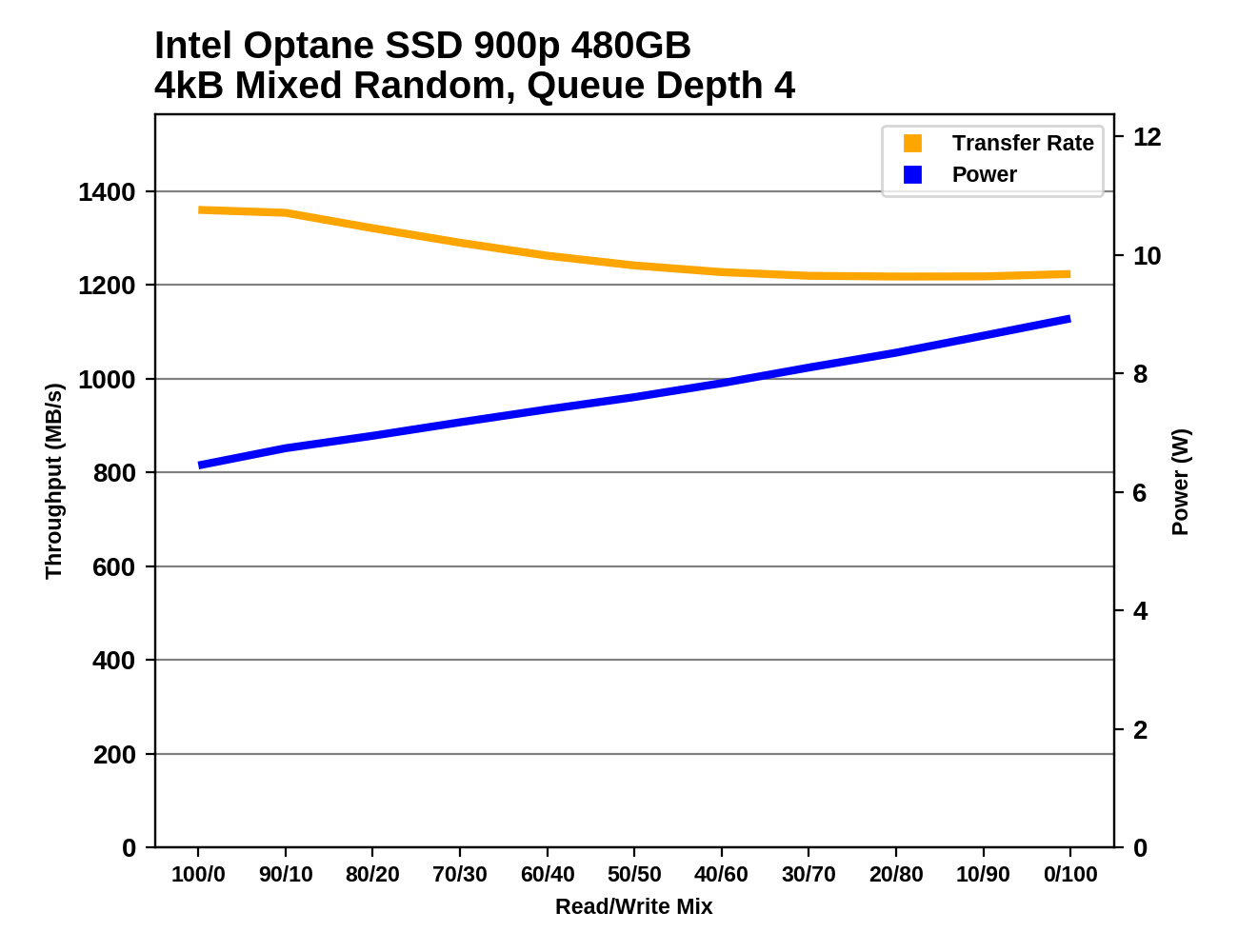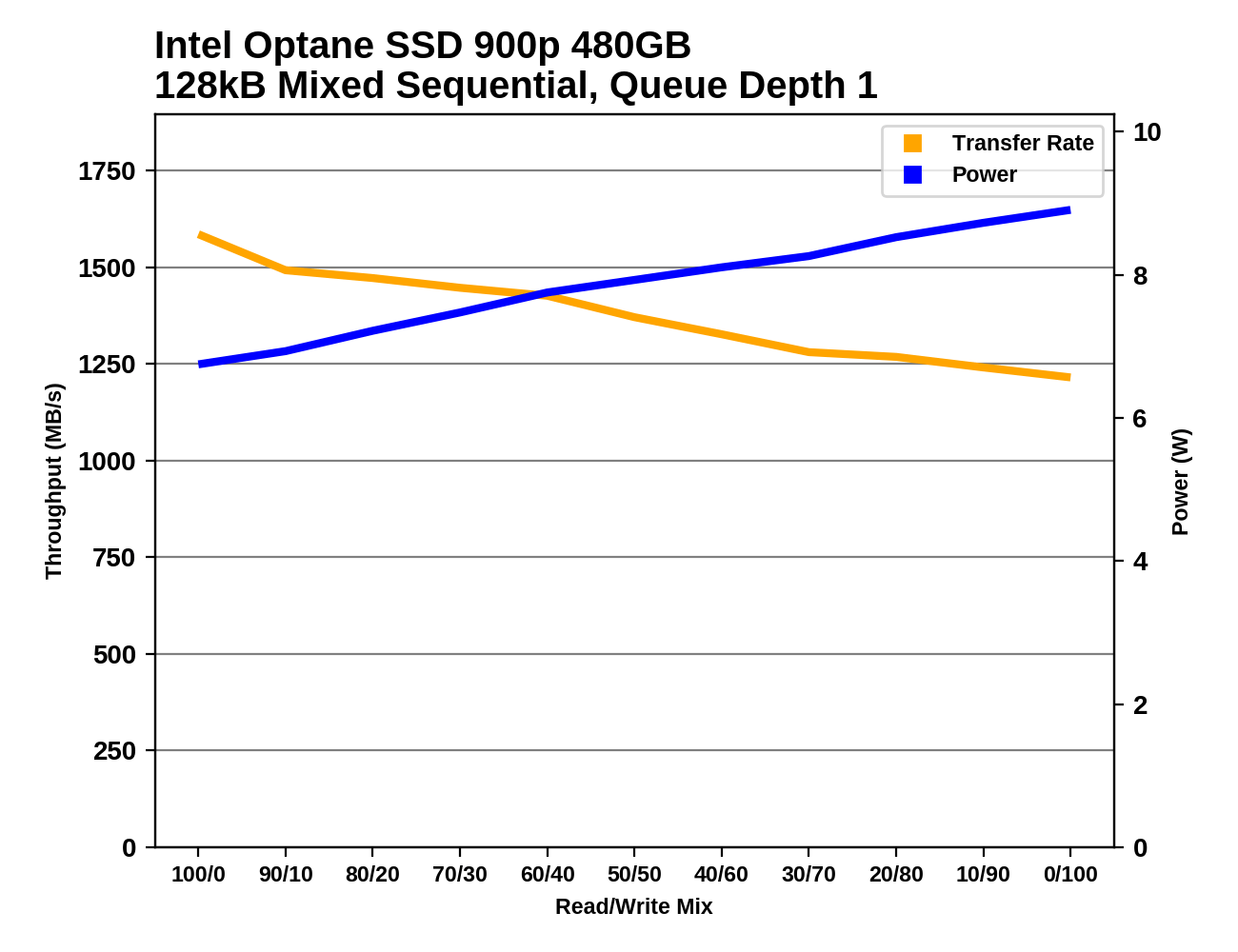The Intel Optane SSD 900p 480GB Review: Diving Deeper Into 3D XPoint
by Billy Tallis on December 15, 2017 12:15 PM ESTMixed Random Performance
Our test of mixed random reads and writes covers mixes varying from pure reads to pure writes at 10% increments. Each mix is tested for up to 1 minute or 32GB of data transferred. The test is conducted with a queue depth of 4, and is limited to a 64GB span of the drive. In between each mix, the drive is given idle time of up to one minute so that the overall duty cycle is 50%.

Since this mixed random I/O test is conducted at the relatively low queue depth of four, the Optane SSDs have a large performance advantage, and even the tiny Optane Memory M.2 does well (though it has to run a slightly modified version of the test due to its low capacity). The Optane SSDs are more than three times faster overall than the highest-scoring flash-based SSD.

The Optane SSDs have a substantial power efficiency lead on the mixed random I/O test, but it is small enough that flash-based SSDs could conceivably catch up with a generation or two of improvements. As usual, the 480GB model has clearly lower efficiency because its minor performance advantage doesn't outweigh the power cost the extra 3D XPoint memory chips.
 |
|||||||||
Both capacities of the Intel Optane SSD 900p show a modest decline in performance as the workload becomes more write-heavy, and a fairly linear increase in power consumption. The 480GB model's power consumption grows slightly faster than the 280GB model, leading to a 0.9W gap at the end of the test.
Even the Intel SSD 750 draws substantially less power for most of the test, though it catches up at the very end. The flash-based M.2 NVMe SSDs are mostly drawing a fraction of what the Optane SSDs require. In terms of performance, none of the flash-based SSDs come at all close to the Optane SSDs until the very end of the test, where many are able to deliver good random write speed.
Mixed Sequential Performance
Our test of mixed sequential reads and writes differs from the mixed random I/O test by performing 128kB sequential accesses rather than 4kB accesses at random locations, and the sequential test is conducted at queue depth 1. The range of mixes tested is the same, and the timing and limits on data transfers are also the same as above.

The Intel Optane SSD 900p is much faster on the mixed sequential I/O test than any consumer flash-based SSD. Samsung's best drives are slower by a third, and it's downhill from there for NAND flash. The 480GB model actually performed slightly worse on this test than the 280GB model, but the difference is small enough it may simply be due to variation between runs.

The power efficiency of the Optane SSD 900p on the mixed sequential I/O test is good but not quite at the top of the charts. Instead, it is on par with the Samsung 960 EVO, which sacrificed a bit of efficiency to improve performance relative to the Samsung 950 PRO.
 |
|||||||||
The 280GB Optane SSD 900p was a bit faster than the 480GB overall but a bit less steady over the course of the test. The scaling of the Optane SSDs is quite similar to the results from the mixed random test: a gradual decline in performance as the proportion of writes increases, and a linear increase in power consumption. The overall performance level is significantly higher than for the random I/O test.
The flash-based SSDs can get much closer to competing with the Optane SSDs on this mixed sequential test than on the mixed random test. Several drives have sequential read speeds that approach that of the Optane SSDs, and a few have higher sequential write performance. But through the middle portions of the test, the flash-based SSDs all lose a lot of their performance for at least a few phases of the test, while the Optane SSD has no acute performance weakness.










69 Comments
View All Comments
Notmyusualid - Sunday, December 17, 2017 - link
So, when you are at gun point, in a corner, you finally concede defeat?I think you need professional help.
tuxRoller - Friday, December 15, 2017 - link
If you are staying with a single thread submission model Windows may we'll have a decent sized advantage with both iocp and rio. Linux kernel aio is just such a crap shoot that it's really only useful if you run big databases and you set it up properly.IntelUser2000 - Friday, December 15, 2017 - link
"Lower power consumption will require serious performance compromises.Don't hold your breath for a M.2 version of the 900p, or anything with performance close to the 900p. Future Optane products will require different controllers in order to offer significantly different performance characteristics"
Not necessarily. Optane Memory devices show the random performance is on par with the 900P. It's the sequential throughput that limits top-end performance.
While its plausible the load power consumption might be impacted by performance, not always true for idle. The power consumption in idle can be cut significantly(to 10's of mW levels) by using a new controller. It's reasonable to assume the 900P uses the controller derived from the 750, which is also power hungry.
p1esk - Friday, December 15, 2017 - link
Wait, I don't get it: the operation is much simpler than flash (no garbage collection, no caching, etc), so the controller should be simpler. Then why does it consume more power?IntelUser2000 - Friday, December 15, 2017 - link
You are still confusing load power consumption with idle power consumption. What you said makes sense for load, when its active. Not for idle.Optane Memory devices having 1/3rd the idle power demonstrates its due to the controller. They likely wanted something with short TTM, so they chose whatever controller they had and retrofitted it.
rahvin - Friday, December 15, 2017 - link
Optane's very nature as a heat based phase change material is always going to result in higher power use than NAND because it's always going to take more energy to heat a material up than it would to create a magnetic or electric field.tuxRoller - Saturday, December 16, 2017 - link
That same nature also means that it will require less energy per reset as the process node shrinks (roughly e~1/F).In general, pcm is a much more amenable to process scaling than nand.
CheapSushi - Friday, December 15, 2017 - link
Keep in mind a big part of the sequential throughput limit is the fact that the Optane M.2s are x2 PCIe lanes. This AIC is x4. Most NAND M.2 sticks are x4 as well.twotwotwo - Friday, December 15, 2017 - link
I'm curious whether it's possible to get more IOPS doing random 512B reads, since that's the sector size this advertises.When the description of the memory tech itself came out, bit addressability--not having to read any minimum block size--was a selling point. But it may be that the controller isn't actually capable of reading any more 512B blocks/s than 4KB ones, even if the memory and the bus could handle it.
I don't think any additional IOPS you get from smaller reads would help most existing apps, but if you were, say, writing a database you wanted to run well on this stuff, it'd be interesting to know that small reads help.
tuxRoller - Friday, December 15, 2017 - link
Those latencies seem pretty high. Was this with Linux or Windows? The table on page one indicates both were used.Can you run a few of these tests against a loop mounted ram block device? I'm curious to see what both the min, average and standard deviation values of latency look like when the block layer is involved.